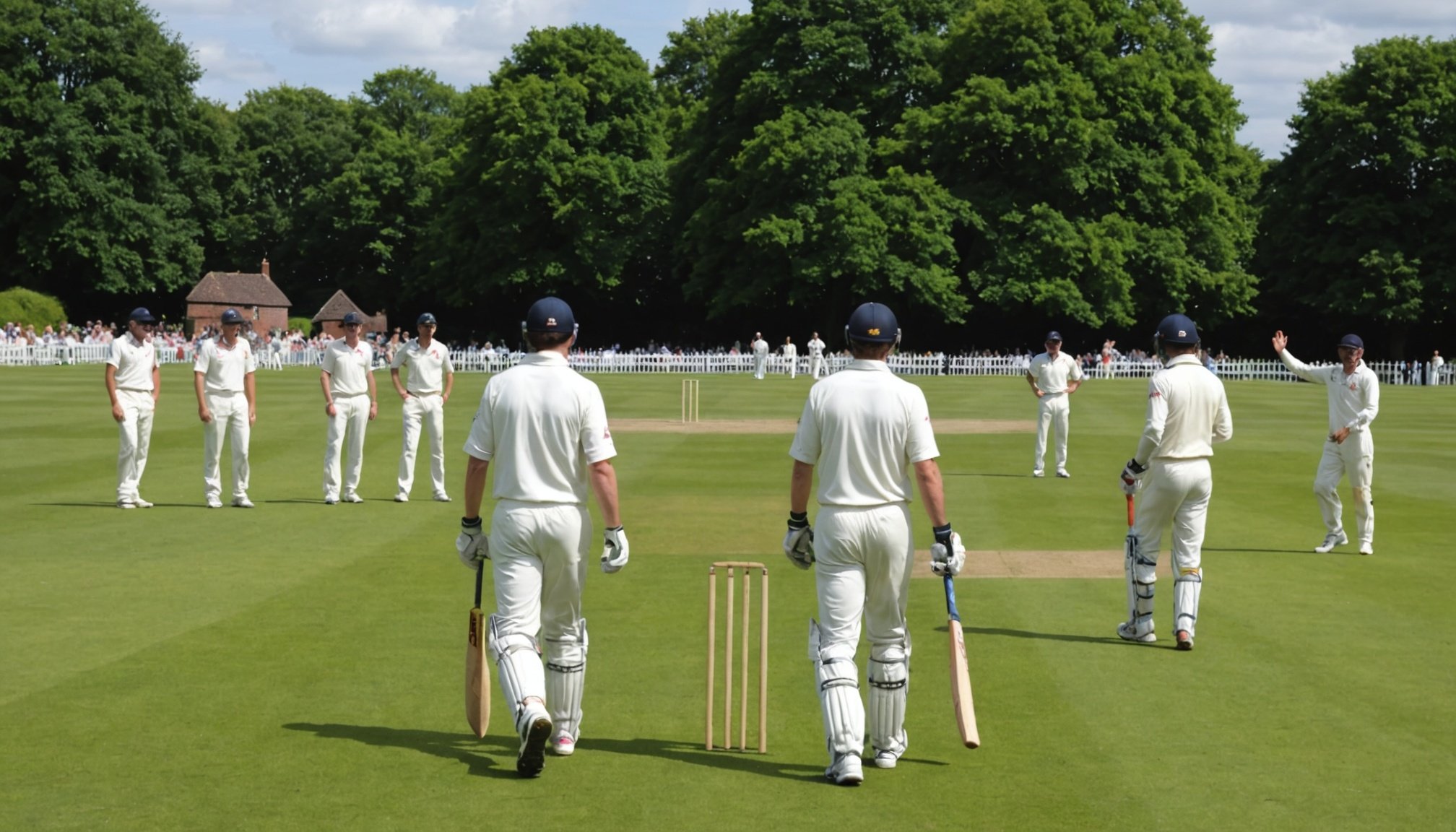Overview of British Village Cricket
Village cricket is deeply rooted in British culture, representing more than just a sport—it is a symbol of rural camaraderie and tradition. Its historical origins can be traced back several centuries, initially emerging in the 17th century. Over time, village cricket evolved from informal gatherings to more structured games, becoming an integral part of British rural life.
The significance of cricket in rural communities is substantial. It is far more than a pastime; it embodies community values and local pride. Villages often rally around their teams, with matches serving as social events that strengthen bonds amongst residents. Each game provides a stage for local customs to thrive and traditions to be passed down through generations.
Also to read : Explore Wales’ Finest Preserved Medieval Castles with Top Rated Guided Tours
Village cricket uniquely reflects aspects of British culture. It shares the quintessential British affinity for fair play, offering an arena where participants uphold the spirit of sportsmanship. Additionally, village cricket fosters an inclusive environment where players of all skill levels participate, promoting community involvement and inclusiveness.
The evolution and persistence of village cricket exemplify the enduring charm and relevance of this cultural institution, highlighting its role in preserving the essence of Britain’s pastoral identity.
Additional reading : Journey Through Time: Uncover the British Monarchy’s Legacy with Engaging Guided Royal Palace Tours
Rules and Structure of Village Cricket
Village cricket offers a delightful blend of tradition and competitive spirit, all within a framework that champions amateur cricket. Understanding the basic rules is essential for both participants and enthusiasts.
Basic Rules of Village Cricket
The game’s structure is straightforward, adhering to the classic principles of cricket. It consists of two teams, usually with 11 players each. The aim is to score more runs than the opposing team. This is achieved by batting and bowling innings, with each team taking turns.
Common Formats and Match Types
Village cricket matches generally follow the limited-overs format, often 40 or 50 overs per side. However, adaptations such as the twenty20 format are also popular for their shorter, more dynamic play. This variety caters to both seasoned players and those new to the game, ensuring everyone’s involvement.
Role of Local Clubs and Organizations
Local clubs are pivotal in organizing matches, fostering a sense of community. These clubs arrange fixtures, ensure adherence to cricket rules, and support the amateur cricket ethos by encouraging participation regardless of skill level. For players, these clubs are gateways to rich community participation and camaraderie.
Attending Village Cricket Matches
Attending a village cricket match offers a rich dive into British culture. Expect a laid-back environment where spectators bring picnic blankets, enjoy leisurely lunches, and immerse in the local setting.
Guidelines for Proper Etiquette
Respect for the game and fellow attendees is key. Applaud good plays from both sides to uphold the cricket spirit. Maintain silence when a player is concentrating, especially a bowler about to deliver. Engage in light conversations but keep noise levels down during play.
Best Practices for Community Engagement
To truly connect with the local community, chat with other attendees. Support the local club by purchasing refreshments. Involvement in post-game gatherings is a great way to learn about local anecdotes and the cricket culture.
Village cricket matches are more than just sporting events—they’re pivotal community events. They represent an opportunity to embrace local traditions, take part in shared experiences, and form new connections. Gaining an understanding of match etiquette ensures a harmonious experience. By showing respect and participating, visitors can enjoy both the game and the broader community atmosphere it fosters.
Participating in Local Matches
Diving into village cricket opens a gateway to community participation and keeps the spirit of amateur sports alive. Local matches provide a platform for all, from seasoned enthusiasts to newcomers.
Opportunities for Involvement in Village Cricket
Joining a cricket team begins with reaching out to local clubs. They often welcome individuals eager to contribute, regardless of skill level. Participation can range from playing to assisting with match arrangements, offering diverse means to get involved.
Tips for Newcomers Wanting to Play
For those new to the game, a basic understanding of cricket and enthusiasm is key. Attend local practices to familiarize yourself with the pace and game structure. Engaging with other players and coaches provides valuable insights and builds confidence.
How to Find Local Matches and Teams
To find local matches, visit community centers or check local bulletin boards where fixtures are announced. These venues often highlight clubs seeking new members. Involvement not only nourishes personal growth but also bolsters the village’s communal cheer and camaraderie. By contributing, individuals play a part in preserving the cherished values of village cricket.
Embracing the Culture of Village Cricket
Village cricket offers a doorway into the heart of British culture through its unique customs and traditions. At its core, this sport mirrors the simplicity and charm of rural life, fostering genuine community bonding.
Unique Customs and Traditions
Engaging in village cricket unveils a tapestry of local customs. Pre-match rituals often include the rolling out of the pitch by volunteers, symbolising teamwork. The sound of a village bell might signal the commencement of play, while post-match gatherings typically involve celebratory toasts with local ales.
The Role of Food and Social Gatherings
Food plays a significant role in these social settings. Homemade treats like scones and sandwiches are staples during matches, offering players and spectators alike a taste of regional hospitality. Social gatherings post-match provide a forum for sharing stories and expanding networks, reinforcing the sport’s communal spirit.
Personal Anecdotes or Stories
Local villagers often share anecdotes of legendary games or notable players who once graced their fields, rooting the sport deeply in community lore. Such stories, passed down through generations, enrich the sport’s narrative, making every game an opportunity to contribute to a living history.
Recommendations for an Unforgettable Experience
Stepping into the world of village cricket offers endless opportunities to create cherished memories. To ensure a truly unforgettable experience, here are some recommendations for visitors eager to immerse themselves in British culture.
Best Regions in the UK to Experience Village Cricket
Some of the most atmospheric matches are found in regions celebrated for their village cricket teams. The picturesque Cotswolds, Yorkshire Dales, and Kent are known for their vibrant cricket scenes. Each location presents stunning landscapes and the charm of rural life, perfect settings for experiencing the essence of village cricket.
Preparing for Your Visit: What to Bring and Expect
Preparation is key to enjoying the match day comfortably. Bring essentials like a picnic blanket, sunscreen, and an umbrella for unpredictable weather. Expect a welcoming atmosphere, with enthusiastic local attendees ready to share stories of their cricket history.
Local Attractions and Activities Surrounding Matches
Extend your visit with nearby activities. From exploring historic sites to enjoying local pubs, these regions offer delights beyond cricket itself. Nature walks, heritage tours, and sampling regional delicacies enhance the overall experience, making it a journey through both sports and culture.
By following these recommendations, visitors can fully embrace village cricket, leaving with both memories and an enriched understanding of rural British culture.











